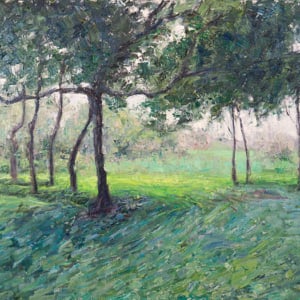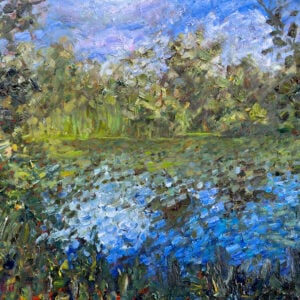Portrait of Madame X, or Madame X, is an elegant portrait by John Singer Sargent featuring a young socialite named Virginie Amélie Avegno Gautreau. Sargent ranked this as one of his best works, but it was also one of his most controversial. In this post, I cover:
- Key Facts
- Color and Light
- Composition
- Brushwork
- Key Takeaways
- Want to Learn More?
- Thanks for Reading!

Key Facts
Here are some of the key facts about Portrait of Madame X:
- Virginie Gautreau (the subject in the painting) was the wife of a wealthy businessman named Pierre Gautreau. She was described as being a “professional beauty”, an English term for people who used their social skills and appearance to advance socially.
- The painting was not a commission, but rather a request by Sargent to paint the young socialite. In a letter to a mutual friend, Sargent wrote:
“I have a great desire to paint her portrait and have reason to think she would allow it and is waiting for someone to propose this homage to her beauty … you might tell her that I am a man of prodigious talent.”
(You can tell Sargent was not shy about his remarkable abilities).
- Madame Gautreau eventually agreed to sit for a portrait by Sargent, who created many studies in preparation for the main work. These studies were done in pencil, watercolors, and oils with several different poses.




- Sargent was frustrated by “the unpaintable beauty and hopeless laziness of Madame Gautreau”. She grew tired of the long sittings with Sargent and had to keep up with her regular social engagements. The painting ended up taking Sargent about two years to complete.
- It was exhibited at the Salon in 1884 and, coming in at an imposing 82 by 43.25 inches, it was meant to make a powerful statement and propel Sargent’s career in portrait commissions. But the painting was instead met with criticism and controversy. At the time, the painting was considered overly-sexual and provocative, mostly due to the off-the-shoulder dress strap (which he ended up painting over due to the controversy). In the study below, you can see what the original off-the-shoulder dress strap looked like.

- Sargent attempted to keep the identity of Madame Gautreau concealed, originally naming the painting Portrait de Mme ***. But, with all the controversy surrounding the painting, her identity quickly became public knowledge. The Gautreau family was embarrassed by this and requested the painting be withdrawn from the Salon. Sargent refused, saying he had painted her “exactly as she was dressed, that nothing could be said of the canvas worse than had been said in print of her appearance”.
- Due to the controversy, Sargent left Paris for London and kept the painting in his studio there. Although the painting was initially a setback for Sargent in Paris, he continued to grow in popularity in England and America. As we now know, he would end up becoming one of the most renowned portrait artists in history.
- Madame Gautreau subsequently posed for two other artists: Gustave-Claude-Etienne Courtois in 1891 and Antonio de La Gandara in 1898. The latter was her favorite.


- The painting was eventually sold to the Metropolitan Museum of Art, not long after the death of Madame Gautreau. The painting is still with that Museum.
Color and Light
Sargent was restrained with his use of color in this portrait, which features a subtle palette of browns, grays, and blacks.
There is a powerful contrast between the soft, light skin tones and the dark, imposing browns and blacks in the rest of the painting. This technique is known as chiaroscuro (which means “light-dark”). Also, notice how most of the light colors are around the subject’s face. It then gets darker as you go towards the bottom of the painting. This helps focus your attention around the top of the painting.
To demonstrate the use of light and dark in the painting, I prepared a simple two-value notan (below). This is a simplified version of the painting with just two values, white and black. White represents the lights and black represents the darks. Notice how much information is conveyed with just these two values. This also shows how mostly light colors were used for the skin tones, and mostly dark colors were used for everything else.

A key feature of Madame Gautreau’s appearance was her pale skin. She was even known to apply a lavender powder which further softened her appearance. To paint the pale skin tones, Sargent used a combination of lead white, rose madder, vermilion, viridian, and bone black. The colors are light and there are no dramatic shifts in color on her skin (apart from her facial features). In particular, notice how Sargent rendered the subject’s neck-line with only the slightest change in color.

The soft, skin tones contrast against the rather dramatic colors and shadows used in the rest of the painting, particularly the silky black dress. On one hand, you have the subtle contours of the face which are depicted with nothing but the slightest of color changes, and on the other hand, you have the imposing blacks and grays picking up the twists and turns in the dress.

Composition
In terms of composition, the focal point is clearly Madame Gautreau, but Sargent also included a table on the left-hand side on which she is resting her hand. The inclusion of the table adds context to the scene and breaks up what would otherwise be a large area of negative space. It also ensures the painting does not appear too centralized.
Madame Gautreau is painted with one arm extended backward, resting on the table, and the other arm relaxed at the front of her body. You can see similar poses in some of Sargent’s studies leading up to this painting. This pose accentuates the general curves and contours of the body, making her appear more relaxed and natural.
There is a pleasing balance between the positive and negative space, with the positive space being the subject and the table, and the negative space being the solid, brown background. The positive space takes up less area in the painting, but it has more impact than the background.

There is also an interesting link between the positive and negative space (or the foreground and background) as the black dress melts into the shadows on the ground.
Finally, on the topic of composition, notice the strong use of outlining around the subject. There is a very strong edge which separates the soft, skin tones from the solid, brown background. This edge is stronger on the right-hand side, suggesting the main light source is also positioned on that side. On the subject’s skin itself, there are hardly any hard edges or outlines, other than the delicate facial features. This further accentuates her soft and pale complexion.
Brushwork
As a whole, the brushwork in this painting is careful and formal. Even the background lacks any playful and relaxed brushwork, with Sargent opting for a more formal, solid background.
Here are some other brief observations about Sargent’s brushwork in this painting:
- The subject’s face and upper body are carefully rendered, with a smooth transition between light and shadow. It lacks the visible brushwork which you can see in many of Sargent’s other paintings.
- The painting jumps between large areas of simple brushwork (the background, top of the table, floor, and most of her upper body) and small areas of intricate brushwork (facial features, parts of the dress, hands, parts of the table).
- For the highlights on the table, Sargent appears to have dragged a light color over a dark foundation (a technique known as scumbling).
- Notice how the Sargent did not attempt to paint the individual strands of hair. He painted the general color shapes, along with a few accents.
Key Takeaways
Here are some of the key takeaways from this painting:
- Use studies to help prepare for more important works. Sargent completed numerous studies in the leadup to this portrait, exploring different mediums, poses, and compositions.
- Do not worry too much about the fickle opinions of others. Even the great Sargent was heavily criticized for what he considered to be one of his best portraits.
- If you want to make a strong statement at an exhibition, then submit a large painting. Just be aware the statement may be for better or worse (in Sargent’s case, it was for worse).
- Sargent demonstrates what is possible with such a dull and limited range of hues. He relied mostly on value contrast in this painting.
- With portrait painting, try to emphasize the curves and contours of the body. This will make your painting appear much more natural and realistic than if you used rigid shapes and lines.

Want to Learn More?
You might be interested in my Painting Academy course. I’ll walk you through the time-tested fundamentals of painting. It’s perfect for absolute beginner to intermediate painters.
Thanks for Reading!
I appreciate you taking the time to read this post and I hope you found it helpful. Feel free to share it with friends.
Happy painting!
Dan Scott

Draw Paint Academy







Hey Dan,
thanks for the overview. Well done.
So interesting….
I feel so blessed to be in a time and location where I can access this kind of information…for free! Thanks so much.
Your explantions are better then what I got in collage. Thank you.
Thank you for this fabulous insight into John Singer Sargent’s approach to this difficult subject. Thank you also for the useful tips you give which I can then incorporate into my paintings! The limited palette is a very useful concept especially as I tend to introduce too much colour too quickly!
This painting but only now with its explanations did I understand the genius of its composition. One thing that always caught my attention was the audacity to paint the arm on the table in that unusual position. Thanks for the painting lesson
Thank you so much for the detailed explanation! I appreciate all your hard work in showing us what to look for in a Master’s painting we otherwise overlook………You are amazing!!!
Wealth of information and insight. Thank you
Excelent!
Dan,
Your analysis of Sargent’s “Madame X” is meaningful, intuitive, insightful and very helpful.
Cheers!
David
Dear Dan,
Thank you for all that you share of your love and understanding of art. My daughter will especially
appreciate your latest article on Madam X.
Best wishes,
Leslie
Fabulous piece Dan…
Thank you so much. I’ve seen the portrait at the Met.
I didnt think of her as beautiful, but the paintings are spectacular.
Thanks Dan!
This article was so great to read. Just last night, I stumbled upon another John Singer Sargant article. The article was about how a great niece of his, who was an expert in textiles, wanted to recreate the extra long scarf he used in several different paintings. He draped the same patterned shawl around several subjects. She managed to recreate a cashmere piece similar to the original using a very old and intricate technique handmade by weavers in India. Look up “John Simger Sargant recreated scarf.” The article was from Elle Decor magazine.😉
Thanks again for another interesting study!
Always Inspired,
Janet M
Loved your analysis and explanations. You made it so clear that I shall be much more focussed when studying paintings in future thanks Sandra
Just wanted to mention, that fashionable ladies of the time, took arsenic to achieve that lavender skin color. I saw this painting in person and it is indeed striking, proving that the color palette should be chosen for the painting. I think these women must have resembled the “corpse bride” in person.
Thank you for your insights on the works of Sergeant.
Thanks Dan. As usual you get the creative juices going. Its now a matter of making the first step and working through the indecission and then establishing the groove that will keep me on course till i finish it. Usually takes a bit of tiime andca mass of critical observations. Good stuff. Even for an old bloke the spin off in other areas is amazing.
Thanks Dan. As usual you get the creative juices going. Its now a matter of making the first step and working through the indecission and then establishing the groove that will keep me on course till i finish it. Usually takes a bit of tiime and a mass of critical observations. Good stuff. Even for an old bloke the spin off in other areas is amazing.
Hi Dan, I love reading your emails, I always learn so much and the subjects you talk about are so interesting, you make me look at paintings from a different angle, thank you for sharing your knowledge I am sure it is appreciated by all that read it
Again, thank you for the wonderful lesson on viewing this painting. I’m learning so much. I did not get an opportunity to take art history in college. I’m so pleased that you are sharing your knowledge with your followers
Dan there is a novel called Strapless by Deborah Davis .Tarcher/Penguin publications
ISBN 1-58542-336-X about John Singer Sargent and the Fall of Madame X .
I just finished it a good read with supporting pictures too. Thank you for your great posts of Levitan
such an inspirational painter helps me really look at the works and study them .
Tnx, Dan for the great lesson.
Did you notice that the ‘repainted’ strap has no shadows under it, making it look hurried? I think the shadow there should have been even darker, yet less distinct than the more lighted side.
Michael
I so appreciate all of your research and content! I am new to your blog and have forwarded your site to my student base of 70 students! Your articles are so well written and have so much substance, not alot of fluff, like many other blogs. Thank you Dan!
Thank you for the great explanations of why artist may do what they do.
I love your “classes”. Lynne
Thanks, Dan. This analysis transforms what could be a brief look at a nice painting into a deep understanding of the background preparation and contrasting development of the form.
Wonderful post. I’ve been studying this portrait, and Sargent in general.
Thank you for such a clear explanation of a very complex piece of art. The only suggestion I could make, to make following it all clearer for me, would be the photo of the finished art repeated more frequently throughout your post. I tend to get whiplash going up and down the page from the analysis of a part of the painting back to the top to view what you have explained. All in all though I am loving your posts.
Did you notice also that the one side (facing the light) that she would present to society has all the rigid, straight lines and stark light, while the side that is away from society is presented ( in the shadows) supported by the table with much more relaxed lines? Just my take on the painting:)
Excelent!
I’m in the middle of copying this painting and this article has given me a deeper insight on how to approach this painting in the final stages. Thank you.
Learned so much and explained clearly. You’ve been most helpful. Thank you.
I thank you so much for your simplicity of explanation
Well done writing about this painting. Thank you for taking the time to show us how and what he did to finish Madame X.
Thank you for this fascinating exposition of the Madame X painting, Dan. I love Singer Sargent’s work, and found this particular painting very striking. Interesting that often the best works of art are not appreciated until much later.
Dear friend,
Too many Comments emails for me. Please remove my name form your Comment list. DO NOT Unsubscribe me from your normal emails. I enjoy them and your sharing of art immensely.
Michael
Hi Michael. At the bottom of comment emails, there should be an unsubscribe button. Could you click on it when you get a chance? I am not sure how to unsubscribe you from my end without stopping all the emails. Glad you enjoy the other emails though! Dan
Dan, can you explain the shadow on the floor behind her dress. There is a large shadow on the right side of the painting that doesn’t seem out of place, but yet doesn’t seem to be natural according to the light source. I would think the shadows would fall to the left of the painting. Perhaps it is the shadow from another piece of furniture and not the dress at all. What are your thoughts?
Hi Loretta. Interesting observation. I would guess that it is the shadow from another object, or there are two light sources. Thanks! Dan
I saw this in person, in a huge exhibition of Sargent’s works in Boston many years ago. It’s hard to describe the luminescent quality he was able to achieve. His talent and skill are astonishing. The story behind “Carnation Lily Rose” shows its not all fun and games achieving great art!
Thanks , Dan. I am out of action with a broken hip and heavy pain killers. Hard to focus on much else at the moment. Your wonderful critique of a subject dear to my heart has stirred the creative juices. It was encouraging to hear of the rejections he surmounted.
Thanks Dan.
I’m currently working on a Family crest, haven’t had much time for this, my wife has been hospitalized after back surgeries for the past three months and it requires a lot of time driving and only have 2 hours to spend with her.
Hello. Thanks for the good information about Sargent’s work. Are you also aware that the subject was from a Louisiana Creole family?
One small quibble: this painting does not rely heavily on chiaroscuro. Chiaroscuro creates the illusion of rounded forms, which Sargent is here purposely underplaying in order to give greater emphasis to the figure/ground relationship, as you rightly point out. If you compare this work to Caravaggio or Rembrandt, who did among the most famous examples of paintings employing chiaroscuro, the differences are clear.
Thank you.